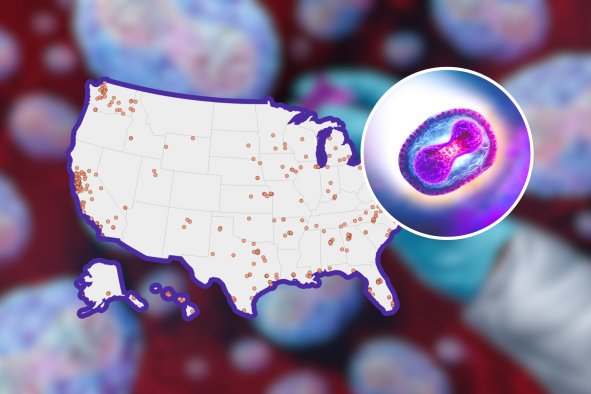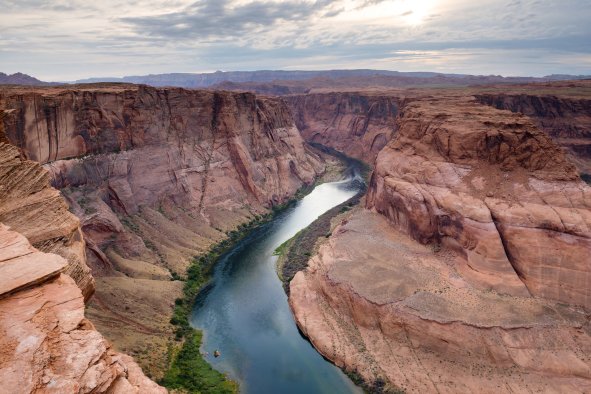The change in water levels predicted for Lake Mead and Lake Powell in 2025 has been announced by the U.S. Bureau of Reclamation.
Lakes Mead and Powell are major reservoirs of the Colorado River, formed by the Hoover Dam and Glen Canyon Dam, respectively. Lake Mead's full pool level is 1,229 feet, and it has a dead pool level of 895 feet. Powell, on the other hand, has a full pool of 3,700 feet and a dead pool of 3,370 feet.
As of August 15, Lake Mead is at 1,062.05 feet above sea level, and Lake Powell is at 3,582.34 feet, Lakes Online showed.
According to the Bureau of Reclamation's projections, on January 1, 2025, Lake Mead will have water levels 1,062.32 feet above sea level, while Lake Powell will be at 3,574.08 feet above sea level.
These projected levels are enough to keep the Colorado River in a Tier 1 water shortage for the coming year, which is the least severe shortage condition.
"Dead pool is when the water above the dam is so low that no water passes through it," Robert Glennon, a water policy and law expert and an emeritus professor at the University of Arizona, previously told Newsweek.
If these reservoirs see their water levels dropping too low, they may approach this crucial dead pool level, wherein they become incapable of providing water to agricultural areas, cities and even hydroelectric plants.
"[Dead pool] would mean no hydropower, no water supply. So there are 40 million people who rely on the Colorado River, and if there's no water coming through Hoover Dam that affects the water supply for 40 million people. And we're talking about the Great Western cities, southwestern cities. We're talking about farmers and we're talking about tribes," Glennon said.
If water levels decrease enough that this becomes a concern, officials will put more severe water shortage tiers into place. These shortage tiers primarily affect water users in the Lower Colorado Basin states (Arizona, Nevada and California) and are designed to trigger reductions in water deliveries when the water levels in Lakes Mead and Powell drop below specific thresholds.
Under Tier 1—which the lakes are in and are expected to remain throughout 2025—southern Nevada sees a 7 percent cut from its standard allocation from the Colorado River of 300,000 acre-feet to 279,000 acre-feet. However, thanks to water conservation efforts, Nevada rarely uses all its allocated amount. Last year, it used 188,000 acre-feet. California doesn't experience any reductions in this tier, but Arizona has to cut its allocation by 512,000 acre-feet, an 18 percent cut from its standard 2.4 million acre-foot allotment. Tier 1 is put into place when Lake Mead drops below 1,075 feet.
"The Colorado River System is already showing significant improvements as a result of water savings from the historic investments in conservation and infrastructure improvements through the Bipartisan Infrastructure Law and Inflation Reduction Act," Reclamation Commissioner Camille Calimlim Touton said in a statement. "These investments provide funding to local, state, and Tribal communities to tackle the climate crisis and unprecedented drought conditions."
Under Tiers 2a and 2b—when Lake Mead drops below 1,050 feet and 1,045 feet, respectively—Arizona and Nevada see larger cuts, but California doesn't have any decreases to its allowance until Tier 3. Tier 3 reflects the most critical conditions, and it is put into place when Lake Mead's water levels drop below 1,025 feet.
Some water conservation groups have said that Tier 1 may overestimate the amount of water that will be in Lakes Mead and Powell in the coming months.
"The Bureau is telling us to expect more big winters, but the data shows the Bureau keeps overestimating future flows," Eric Balken, the executive director of the Glen Canyon Institute, said in a statement. "One or two bad winters and we are back in crisis mode at Powell and Mead. That is the real story."
"We are playing with loaded dice," Zach Frankel, the executive director of the Utah Rivers Council, said in the statement. "The big winter of 2023 created the misconception that reservoir levels were going to rebound, but America's two largest reservoirs are only [about] 37 percent full. That's like winning the lottery and still being bankrupt."
Do you have a tip on a science story that Newsweek should be covering? Do you have a question about the Hoover Dam? Let us know via science@newsweek.com.
Disclaimer: The copyright of this article belongs to the original author. Reposting this article is solely for the purpose of information dissemination and does not constitute any investment advice. If there is any infringement, please contact us immediately. We will make corrections or deletions as necessary. Thank you.



